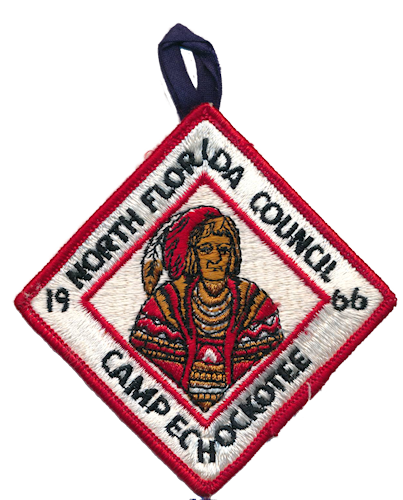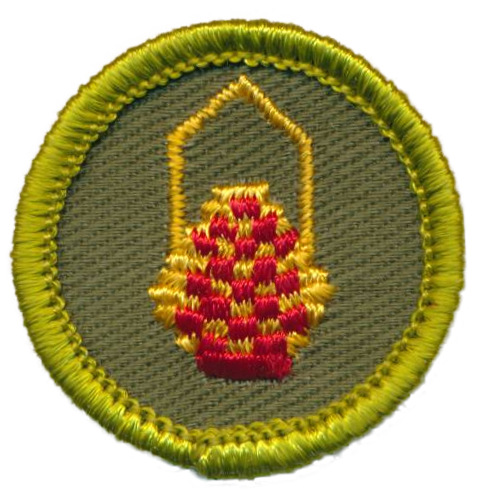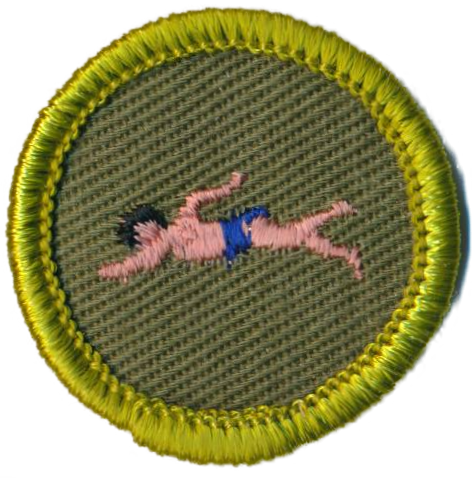


1966
Boy Scout Camp
 In
July David and I again went to Camp Echockotee for a week. I was
more focused merit badges then the previous year and I earned the
Basketry and Swimming merit badges. Work on the Basketry merit
badge was done at the camp crafts hut next to the woodworking shop.
While I really liked the woodworking shop, the crafts hut ran a
close second with its many different kits to make all sorts of
things. The kits were not free, costing from 50¢ to a couple of
dollars, so with my limited funds I had to carefully choose which
kits I wanted to make. A braded bracelet,
In
July David and I again went to Camp Echockotee for a week. I was
more focused merit badges then the previous year and I earned the
Basketry and Swimming merit badges. Work on the Basketry merit
badge was done at the camp crafts hut next to the woodworking shop.
While I really liked the woodworking shop, the crafts hut ran a
close second with its many different kits to make all sorts of
things. The kits were not free, costing from 50¢ to a couple of
dollars, so with my limited funds I had to carefully choose which
kits I wanted to make. A braded bracelet,
 a
braded neckerchief but had to save money for Basketry which cost
$1.50 for the materials. It went quickly and soon I had woven a
square basket, a round basket and a campstool seat which along
answering some questions about basketry, I earned the Basketry Merit
badge.
a
braded neckerchief but had to save money for Basketry which cost
$1.50 for the materials. It went quickly and soon I had woven a
square basket, a round basket and a campstool seat which along
answering some questions about basketry, I earned the Basketry Merit
badge.
While the basketry merit badge was easy, the Swimming Merit Badge
was more of a challenge, but I thought I was up for it having spent
a lot of time around water at the ocean, lakes, and many hours at
Grandpa Junior’s pool. I got the badge requirement card and looked
it over, and thought, okay, this was going to be a bit harder than I
initially thought. I had taken swimming lessons several years ago
and learned basic swimming badge required you to demonstrate all
sorts of strokes, sidestroke, breaststroke, crawl, trudgen and
backstroke. In addition, you had to demonstrate water rescue,
diving, and other things.
 Fortunately,
we met every day for over an hour and the instructor taught all the
things we needed and better yet, we got to spend a lot of time in
the pool which was particularly nice on the hot summer days. It
went well, I learned a lot and by the end of camp had completed all
the requirements earning the Swimming Merit Badge.
Fortunately,
we met every day for over an hour and the instructor taught all the
things we needed and better yet, we got to spend a lot of time in
the pool which was particularly nice on the hot summer days. It
went well, I learned a lot and by the end of camp had completed all
the requirements earning the Swimming Merit Badge.
Another merit badge I worked on was Canoeing. Canoeing instruction was held on the lake which required yet another swim test with things like jump in the water over your head and then swim 100 yards. No problem for me there for I had completed the Mile Swim the day before. I showed up along with two dozen other boys sitting on the beach for the first lesson which started with the basics, this is a paddle, this is the handle of the paddle, this is the end that goes into the water. Okay this started a bit slow after all I had been canoeing with my Dad quite a few times but soon got to putting on your life jackets and soon we were all jacketed up and heading to the water where the instructor explained the parts of the canoe, how to get in and how to launch then had the boys paired up and stand by a canoe. The instructor thing gave us instructions, launch our canoes, paddle around a buoy a hundred yards out, and then return back to shore. Well imagine a dozen canoes with two dozen boys, for many their first time in a canoe, pushing their canoes out into the water, climbing in, and then paddling out into the lake. It was chaos with canoes going every which way, canoes colliding with others, boys yelling to paddle one way or another, or more importantly yelling “Look out!” I had the wisdom at launch time to take the stern of the canoe with the boy assigned as my partner taking the front. If you have never experienced the joy of canoeing, then you should know that the person in the back of the canoe is the one the does 90% of the steering which involves directing the person in the bow on which side to paddle on. Now don’t get me wrong, the person in the bow with a more forward view also has responsibilities like looking out for obstacles and providing direction.
With me in the back, my partner in the front, we shove the canoe off from shore enough to get it to float and I held the canoe while my partner climbed in and the I climbed in behind him and we begin to paddle. As I look behind me, I see the chaos beginning, some boys didn’t push their canoes out far enough and were paddling vainly while the back of their canoe was stuck in the sand. Other boys pushed their canoes out too deep and had difficulty getting in, almost capsizing the canoe in the process. Now our canoe wasn’t the only one that got off with a good start, there were two or three others and soon the group paddled away from the chaos on the shore behind us. We continued to paddle, me often with my paddle in the water to steer while my partner paddled but I also paddled, and we continued out towards the buoy a 100 yards out. Now paddling in a straight line in a canoe isn’t as simple as one would first think, if both row on the same side you will turn. Paddling on opposite sides doesn’t necessarily mean you will go straight, there has to be a balance of the two. We did well, my partner rowing mostly on his stronger side but I was able to compensate in the back and we soon approached the buoy. Now came the challenge making a U-turn around the buoy. My partner rowed, I rowed and ruddered and, while a bigger turn then I would have liked, we came about and headed back to shore and that’s when our problems really begin. Two other canoes made it along with us around the buoy seeing the other nine canoes going in every which direction, crisscrossing, cutting in front of each other, boys yelling to look out, it was chaos and we had to paddle though it to get back to shore. It was a challenge but I was up for it, we continue ahead, another canoe was going to cross our path, I yell “paddle right”, I steer and we comfortably pass the other canoe only to see another, I yell “paddle left hard” and I paddle hard and we barely miss when, thump, I look to my other side and see a boy in a passing canoe pushing off us with his paddle, that was a close one. With the other canoes heading outward, the traffic thinned as heading to shore where we softly beached the canoe and get out. Standing on the shore I look out and the chaos had lessened and were mostly heading in the right direction.
Canoeing was a multiple day course. On the second day we learned how to properly secure a canoe with rope, using ,the most fundamental scouting skill, knots. Ok learning tautline and bowline were actually useful. Next subject, steering using different type of stokes, “there were more strokes than paddle” I thought, well I soon learned that other than the forward stroke that I knew as just “paddle”, there is the backstroke, draw stroke, j-stroke, sweeps, and so on. We put on our life vests and head out with it being considerably more orderly, the boys were learning. There were more subjects, safety, equipment and one last test, recover from a sinking canoe. We were told what to do, paddle out over fifty feet where the water was over our head, tip the boat, filling it with water and sinking it. It is not as risky as you might first think for canoes were made from fiberglass and had built in floatation at each end and thus would not sink, so the instructor explained. They do sink we found out, just not sink to the bottom of the lake. We paddle out and we both lean as far as we can to one side, the edge of the canoe tips under the water and the canoe quickly fills with water and we fall out into the water. No problem, that was the plan and we had life jackets on, so we floated there beside the canoe filled with water with about two inches above the water. So next per instruction, we are to climb back in which isn’t so hard with it so low in the water and my partner and I easily did, then sitting there it occured to me, Oh wait, we were supposed to hang onto our paddle, and see mine floating a few feet away. Well I found you can move a sunken canoe without a paddle so I fall out of the canoe, swim over getting my partner’s and my paddles, swimming back, handing the paddles to my partner before climbing back in. Part of the safety equipment that every canoe had was a bailer made from a plastic Clorox jug with one side cut out making a scoop with it then tied with a short piece of rope to the canoe so you can’t lose it. I begin bailing, a canoe holds a lot of water, this was going to take a while, and it was complicated but if either you or your partner leaned a little to one side or the other, water will spill back in. Ok, learned that lesson quick, sit still, bail, and soon the canoe begin to rise out of the water. With it higher in the water I could lean forward and give the bailer to my partner and let him bail and soon the canoe was mostly empty, at least until we could get it back to shore where you lean how heavy a canoe with a little water in it is as we then, standing in the water, had to lift the canoe up, turn it to the side draining the last of the water out. Such lessons I tucked away in my mind sometimes long forgotten to spring forth much later in life such as draining a canoe did fifty some years later.
Updated: 09-22-2022